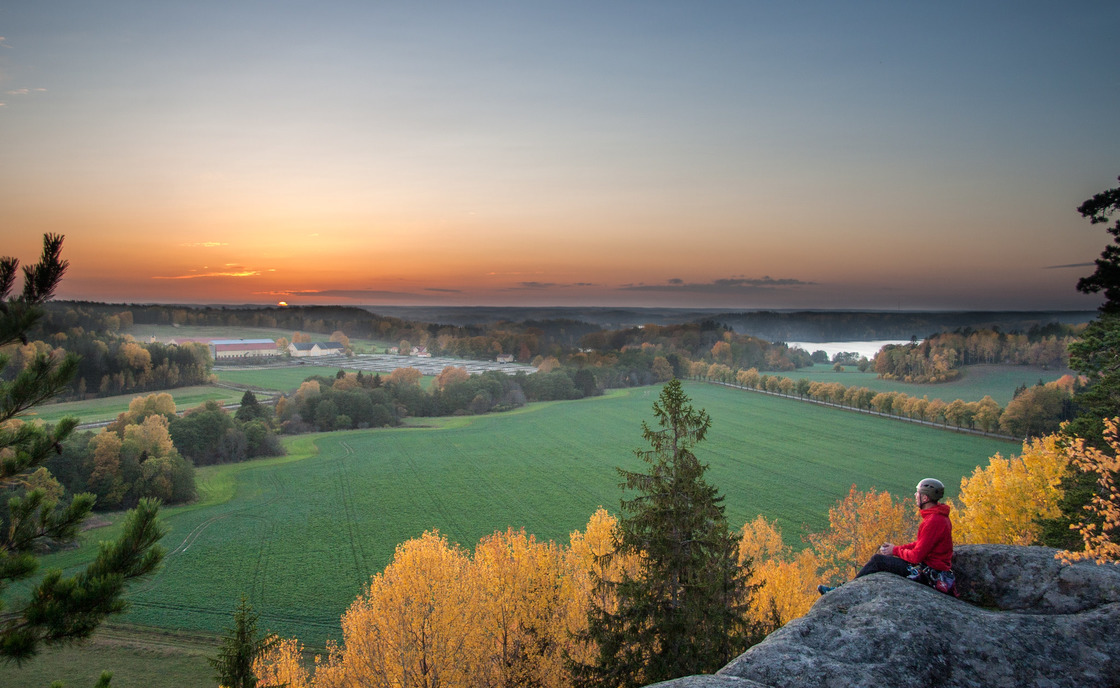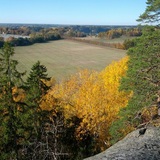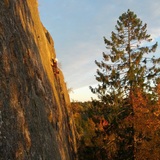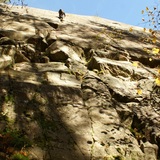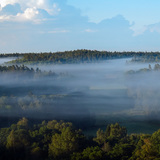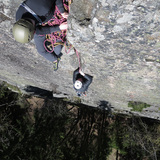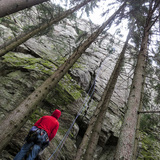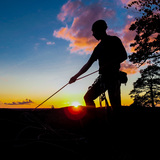Thirty meters high and about a hundred fifty meters wide crag that houses some of Stockholm's best and longest trad climbing routes. The wall is just below 90 degrees so it is important to mobilize the footwork in the best possible way. Two sets of nuts (perhaps unnecessary to double the largest) and a few small to medium-sized cams are usually enough for most routes. Note that this is only a general recommendation as there are exceptions, some cracks swallow lots of small wires, for example. In order to maintain a good relationship with landowners and residents in the area, the approach to the crag takes place from above, although It's very easy to get down to the base of the crag via a steep trail/path and some big ledges (you can activate this trail in the app, making it easier finding the steep trail down to the base of the crag).
There are some pitons and bolts here and there on the crag and the condition of these can vary a lot. The more frequently climbed routes are usually in good condition, while other climbs may need some brushing, so bring a brush.
There is a lowering chain behind a big rock at the far left (climber's view) of the rock just before the walkable "downclimb".
Environment:
Southwest facing. The upper part dries quickly. The lower part is often moist for a little longer. However, this is seldom a problem because the lower parts of the wall are more broken and usually considered easier than the upper parts. It is nicest to have the camp at the top during the stay. Most people probably prefer the mile-wide view in front of the mosquito-contaminated environment at the foot of the crag, although, in spring and autumn it's quite nice at the bottom as well.
History by Claes Jelinek (translated by Mikael Widerberg):
Grönbrinksberget is one of Stockholm's most popular crags and offers long, high-class routes. The old pioneers are said to have been here and examined the possibilities long ago, but for some reason the rock was ignored.
Karl-Erik Henriksson rediscovered the crag in the autumn of 1978 and made the first route, Kaminen, together with Petteri Tuppaka. The next day, Kaminen received the second ascent of PO Bergström and Lasse Svadängs. Before the day was over, Bergström together with Svadängs had generated Bergströms fjärtström (5-).
Next spring, Uffes Under was done by Ulf Lagercrantz and Svadängs. A lot of dust and moss swirled around Svadängs when he cleaned up a project later that year, the result of which was Åke Svenssons hörn (5+) which was named after a professor researching lung diseases. Rikard Hedman returned from a long Yosemite stay and slipped up for Klart spänt (7-). Among the other "athletes'' a certain frustration spread as they had shortly before made heavy-footed attempts at top ropes. Later, the business was dominated mainly by Janne Liliemark and Svadängs. When Janne was at a training camp for badminton players, Lasse took the opportunity to, together with Rikard, grab Liliemarks träningsläger (6+). Svadängs recognized strong climbing psyche and his refined foot technique in thin wall climbing as well as his ability to place gear where no one else succeeded made many back off if he thought a route "was maybe a little scary". Lasse has made a number of new routes in Stockholm, Bohuslän and the magnificent Hykieberget in Älvdalen. Björnerstedt, Grankvist and Liliemark have often been involved in these works.
Per-Elof Lidström and Roger Pyddoke were involved in the initial phase of the rock's development and opened, among others, Snuffy Duffy and Tutti-Frutti at the right edge of the crag.
Bolts have also been placed on this rock, but so far almost all routes require nuts and cams to be protected in a secure manner. Climbs such as Löjliga familjen, Skinnhissen, Stålmannen and Lex Luthor are some examples of this. The latter is made by Henrik Bolander, one of the better on-sight climbers at the time in Sweden. Henrik used to cope with hard repetitions very quickly, either on-sight or after only a few attempts.


